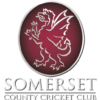

Derbyshire conclude their Metro Bank One Day Cup campaign with a home fixture against Somerset at The Incora County Ground.
Heritage Officer David Griffin previews the match.
One of the vagaries of modern domestic cricket means that Derbyshire and Somerset will be meeting in a white ball match at Derby for the first time since the home side won a high-scoring NatWest Pro40 League game by seven wickets in 2006. That match was played in early September under floodlights and the visitors made an imposing 277 for three in 40 overs, James Hildreth scoring 122 before Travis Birt struck a run a ball 108 supported by contributions from Michael Di Venuto (58) and Chris Taylor (60) to see Derbyshire home by a comfortable margin with eight balls to spare.
These two counties have produced some truly memorable one day cricketing occasions including a quarter final match in the Gillette Cup in 1977 when 11,000 spectators, a record for any Derbyshire one day game at home, crammed into the Rutland Ground at Ilkeston to see a young Ian Botham alongside Viv Richards, Joel Garner and Brian Close take on a Derbyshire side featuring Eddie Barlow, John Wright, Bob Taylor, Mike Hendrick and Geoff Miller; while in 2015 a match reduced to 14 overs per side at Taunton saw the home side dismissed for just 74 in only 10 overs after Derbyshire had made 134 for seven.
This will be the 51st scheduled one day match between the sides since their first encounter in the Gillette Cup in 1969, a game Derbyshire won by three wickets at Taunton. In a classic example of the approach to one day cricket in those early days of the shorter form of the game, Somerset were dismissed for 144 in 59 overs with Derbyshire’s most expensive bowler, Derek Morgan, conceding a meagre three runs per over.
In reply, Derbyshire used all but three balls of their allotted 60 overs to reach their target. At one stage they were 76 for no wicket having used 37 overs (11 maidens) to get there and had to make the last 31 runs off 39 deliveries to win the match.
Derbyshire won 18 of these games, Somerset 28, with three matches abandoned and one ending as no result. The no result game paradoxically did produce a result in the quarter final of the Benson and Hedges Cup at Taunton in 1993.
The game had a spare day set aside to cater for potentially inclement weather, an eventuality much-needed then although something rarely considered in domestic cricket in the modern game.
The game began after a delayed start and Derbyshire reached 69-0 after 20.3 overs, before further heavy rain left no further play possible.
Both captains, Kim Barnett and Chris Tavare debated – at times forcefully – the options for a restarted game on the second day, the umpires at this time not being the sole arbiters of conditions being fit or otherwise for play. The first game was therefore concluded as no result, and with the skippers unable to agree on a 10- or 20-over game, it was decided that a bowl-out was the only way to determine the winners of the tie.
In 1991, Derbyshire had been the first county to suffer a bowl-out defeat at the hands of Hertfordshire at Bishop’s Stortford in a NatWest Trophy tie, and lessons had been learned from that disaster. Instead of using specialist seam bowlers, who had bowled standard, just outside the top of off stump deliveries at Bishop’s Stortford, Barnett turned to Matthew Vandrau, Chris Adams, Pater Bowler, and himself, plus Dominic Cork to each deliver two balls.
A mixture of slow non-spinning deliveries and full tosses were the order of the day as Vandrau (1), Adams (2), Barnett (1), Cork (1) and Bowler (1) struck the unguarded stumps 6 times to win the bowl-out 6-3.
It was a wholly unsatisfactory way to decide a cricket match, but there was no alternative; two days had been scheduled to complete the game, but the rain simply didn’t relent long enough for the game to take its normal course. Even the bowl-out took place in terrible conditions.
One of the more dramatic endings to a one-day game involving Derbyshire came at Taunton in 1990. This was the season when Derbyshire won the RAL Sunday League, and this match was one of many which highlighted the strength of Derbyshire’s formidable batting line-up.
Somerset scored 258 for seven after being asked to bat by Kim Barnett and it appeared from the boundary at least, to be a formidable target.
However, one of the finest partnerships in the county’s history between Barnett and John Morris, the latter opening because Bowler was missing, took Derbyshire to 232 before the first wicket fell.
It remains the highest-ever partnership in one day cricket in Derbyshire’s history against a first-class county – only Alan Hill and Iain Anderson with 286 v Cornwall in 1986 have bettered it.
The pair batted gloriously, looking at one point as if they might take their side to a 10-wicket victory.
The South African Adrian Kuiper, who made such a wonderful impact on Derbyshire’s golden summer, strode in when the first wicket fell but eight runs later Allan Warner was joining him and when the latter fell for four, Chris Adams walked out to bat with one ball remaining and the scores level.
Adams was at the non-striker’s end, as Kuiper faced Roland Lefebvre. Adams later reported that Kuiper had advised him to: “…run as hard as you can. I’ll try to get bat on ball…”
Adams set off, head down, as Lefebvre released the ball and Kuiper rocked back, smashing the ball high and hard into the churchyard. For this writer, it remains one of the finest moments in 50 years of watching Derbyshire.
Derbyshire’s highest innings total against Somerset is 303 for seven at Taunton in 1990 while Somerset’s best of 316 for five was at Derby in 2004.
Derbyshire players have registered 10 List A hundreds against Somerset with Barnett, Bowler and Morris all getting two, with Bowler’s unbeaten 138 at Derby in 1993 the highest.
No Derbyshire bowler has taken five Somerset wickets in one day cricket, the best return coming from Phill Russell who took four for 36 at Taunton in 1972.